The Impact of Design on Clinical Care in Childbirth

How does healthcare design influence the rate of C-sections?
Across the U.S., a woman’s chance of delivering by cesarean section varies tremendously from one hospital to another, even when other risk factors are taken into consideration. The hospital itself is a risk factor for delivery by c-section. How does the building help or hinder the processes of caring for women during labor and delivery? Both clinicians and architects appreciate the relationship between form and function—nonetheless many healthcare facilities are not designed with both of these in mind. Even though mothers in labor are typically some of the healthiest patients in a hospital setting, they often are treated in intense treatment environments designed for the sickest.
With funding from the Robert Wood Johnson Foundation (RWJF), MASS Design Group is partnering with Ariadne Labs, a joint center between Brigham and Women’s Hospital and the Harvard T. H Chan School of Public Health, to understand how design impacts clinical processes, decisions and outcomes during childbirth. Our team analyzed floor plans of twelve diverse U.S. birth facilities - from independent, free-standing birth centers to large tertiary care academic hospital labor and delivery wards; from rural Arizona to metropolitan Boston; from the smallest patient volume to among the largest in the country. Our investigation reveals some compelling relationships between a number of design elements of birth spaces and the care that is provided. In future phases of this research, we aim to create guidelines for designers and facilities undergoing construction or renovation of their spaces to design around providing optimal care in childbirth.
Project Details
41.112469, -73.265076
Location: USA
Year: 2017
Status: Complete and Available for Download
Program: Report, Graphic Analysis
Services: Reporting and Synthesis of Findings
Clients:
Robert Wood Johnson Foundation
Partners:
Ariadne Labs

